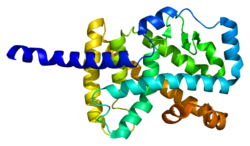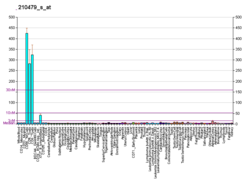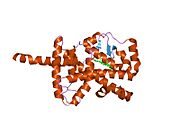RAR-related orphan receptor alpha
RAR-related orphan receptor alpha (RORα), also known as NR1F1 (nuclear receptor subfamily 1, group F, member 1) is a nuclear receptor that in humans is encoded by the RORA gene.[5] RORα participates in the transcriptional regulation of some genes involved in circadian rhythm.[6] In mice, RORα is essential for development of cerebellum[7][8] through direct regulation of genes expressed in Purkinje cells.[9] It also plays an essential role in the development of type 2 innate lymphoid cells (ILC2) and mutant animals are ILC2 deficient.[10][11] In addition, although present in normal numbers, the ILC3 and Th17 cells from RORα deficient mice are defective for cytokine production.[12]
Discovery
The first three-human isoforms of RORα were initially cloned and characterized as nuclear receptors in 1994 by Giguère and colleagues, when their structure and function were first studied.[13]
In the early 2000s, various studies demonstrated that RORα displays rhythmic patterns of expression in a circadian cycle in the liver, kidney, retina, and lung.[14] Of interest, it was around this time that RORα abundance was found to be circadian in the mammalian suprachiasmatic nucleus.[15] RORα is necessary for normal circadian rhythms in mice,[16] demonstrating its importance in chronobiology.
Structure
The protein encoded by this gene is a member of the NR1 subfamily of nuclear hormone receptors.[16] In humans, 4 isoforms of RORα have been identified, which are generated via alternative splicing and promoter usage, and exhibit differential tissue-specific expression. The protein structure of RORα consists of four canonical functional groups: an N-terminal (A/B) domain, a DNA-binding domain containing two zinc fingers, a hinge domain, and a C-terminal ligand-binding domain. Within the ROR family, the DNA-binding domain is highly conserved, and the ligand-binding domain is only moderately conserved.[14] Different isoforms of RORα have different binding specificities and strengths of transcriptional activity.[5]
Regulation of circadian rhythm
The core mammalian circadian clock is a negative feedback loop which consists of Per1/Per2, Cry1/Cry2, Bmal1, and Clock.[15] This feedback loop is stabilized through another loop involving the transcriptional regulation of Bmal1.[17] Transactivation of Bmal1 is regulated through the upstream ROR/REV-ERB Response Element (RRE) in the Bmal1 promoter, to which RORα and REV-ERBα bind.[17] This stabilizing regulatory loop itself is induced by the Bmal1/Clock heterodimer, which induces transcription of RORα and REV-ERBα.[15] RORα, which activates transcription of Bmal1, and REV-ERBα, which represses transcription of Bmal1, compete to bind to the RRE.[17] This feedback loop regulating the expression of Bmal1 is thought to stabilize the core clock mechanism, helping to buffer it against changes in the environment.[17]
Mechanism
Specific association with ROR elements (RORE) in regulatory regions is necessary for RORα's function as a transcriptional activator.[18] RORα achieves this by specific binding to a consensus core motif in RORE, RGGTCA. This interaction is possible through the association of RORα's first zinc finger with the core motif in the major groove, the P-box, and the association of its C-terminal extension with the AT-rich region in the 5’ region of RORE.[16]
Homology
RORα, RORβ, and RORγ are all transcriptional activators recognizing ROR-response elements.[19] ROR-alpha is expressed in a variety of cell types and is involved in regulating several aspects of development, inflammatory responses, and lymphocyte development.[20] The RORα isoforms (RORα1 through RORα3) arise via alternative RNA processing, with RORα2 and RORα3 sharing an amino-terminal region different from RORα1.[5] In contrast to RORα, RORβ is expressed in Central Nervous System (CNS) tissues involved in processing sensory information and in generating circadian rhythms while RORγ is critical in lymph node organogenesis and thymopoeisis.[20]
The DNA-binding domains of the DHR3 orphan receptor in Drosophila shows especially close homology within amino and carboxy regions adjacent to the second zinc finger region in RORα, suggesting that this group of residues is important for the proteins' functionalities.[5]
PDP1 and VRI in Drosophila regulate circadian rhythm's by competing for the same binding site, the VP box, similarly to how ROR and REV-ERB competitively bind to RRE.[17] PDP1 and VRI constitute a feedback loop and are functional homologs of ROR and REV-ERB in mammals.[17]
Direct orthologs of this gene have been identified in mice and humans.
Human cytochrome c pseudogene HC2 and RORα share overlapping genomic organization with the HC2 pseudogene located within the RORα2 transcription unit. The nucleotide and deduced amino acid sequences of cytochrome c-processed pseudogene are on the sense strand while those of the RORα2 amino-terminal exon are on the antisense strand.[5]
Interactions
- DNA: RORα binds to the P-box of the RORE.[16]
- Co-activators:
- Ubiquitination: RORα is targeted for the proteasome by ubiquitination. A co-repressor, Hairless, stabilizes RORα by protecting it from this process, which also represses RORα.[21]
- Sumoylation: UBE21/UBC9: Ubiquitin-conjugating enzyme I interacts with RORs, but its effect is not yet known.[16]
- Phosphorylation:
- Phosphorylation of RORα1, which inhibits its transcriptional activity, is induced by Protein Kinase C.[14]
- ERK2: Extracellular signal-regulated kinase-2 also phosphorylates RORα.[22]
- ATXN1: ATXN1 and RORα form part of a protein complex in Purkinje cells.[16]
- FOXP3: FOXP3 directly represses the transcriptional activity of RORs.[16]
- NME1: ROR has been shown to specifically interact with NME1.[23]
- NM23-2: NM23-2 is a nucleoside diphosphate kinase involved in organogenesis and differentiation.[6]
- NM23-1: NM23-1 is the product of a tumor metastasis suppressor candidate gene.[6]
As a drug target
Because RORα and REV-ERBα are nuclear receptors that share the same target genes and are involved in processes that regulate metabolism, development, immunity, and circadian rhythm, they show potential as drug targets. Synthetic ligands have a variety of potential therapeutic uses, and can be used to treat diseases such as diabetes, atherosclerosis, autoimmunity, and cancer. T0901317 and SR1001, two synthetic ligands, have been found to be RORα and RORγ inverse agonists that suppress reporter activity and have been shown to delay onset and clinical severity of multiple sclerosis and other Th17 cell-mediated autoimmune diseases. SR1078 has been discovered as a RORα and RORγ agonist that increases the expression of G6PC and FGF21, yielding the therapeutic potential to treat obesity and diabetes as well as cancer of the breast, ovaries, and prostate. SR3335 has also been discovered as a RORα inverse agonist.[13]
See also
References
- ^ a b c GRCh38: Ensembl release 89: ENSG00000069667 – Ensembl, May 2017
- ^ a b c GRCm38: Ensembl release 89: ENSMUSG00000032238 – Ensembl, May 2017
- ^ "Human PubMed Reference:". National Center for Biotechnology Information, U.S. National Library of Medicine.
- ^ "Mouse PubMed Reference:". National Center for Biotechnology Information, U.S. National Library of Medicine.
- ^ a b c d e Giguère V, Tini M, Flock G, Ong E, Evans RM, Otulakowski G (March 1994). "Isoform-specific amino-terminal domains dictate DNA-binding properties of ROR alpha, a novel family of orphan hormone nuclear receptors". Genes & Development. 8 (5): 538–53. doi:10.1101/gad.8.5.538. PMID 7926749.
- ^ a b c "Entrez Gene: RORA RAR-related orphan receptor A".
- ^ Sidman RL, Lane PW, Dickie MM (August 1962). "Staggerer, a new mutation in the mouse affecting the cerebellum". Science. 137 (3530): 610–2. Bibcode:1962Sci...137..610S. doi:10.1126/science.137.3530.610. PMID 13912552. S2CID 30733570.
- ^ Hamilton BA, Frankel WN, Kerrebrock AW, Hawkins TL, FitzHugh W, Kusumi K, Russell LB, Mueller KL, van Berkel V, Birren BW, Kruglyak L, Lander ES (February 1996). "Disruption of the nuclear hormone receptor RORalpha in staggerer mice". Nature. 379 (6567): 736–9. Bibcode:1996Natur.379..736H. doi:10.1038/379736a0. PMID 8602221. S2CID 4318427.
- ^ Gold DA, Baek SH, Schork NJ, Rose DW, Larsen DD, Sachs BD, Rosenfeld MG, Hamilton BA (December 2003). "RORalpha coordinates reciprocal signaling in cerebellar development through sonic hedgehog and calcium-dependent pathways". Neuron. 40 (6): 1119–31. doi:10.1016/s0896-6273(03)00769-4. PMC 2717708. PMID 14687547.
- ^ Halim TY, MacLaren A, Romanish MT, Gold MJ, McNagny KM, Takei F (September 2012). "Retinoic-acid-receptor-related orphan nuclear receptor alpha is required for natural helper cell development and allergic inflammation". Immunity. 37 (3): 463–74. doi:10.1016/j.immuni.2012.06.012. PMID 22981535.
- ^ Gold MJ, Antignano F, Halim TY, Hirota JA, Blanchet MR, Zaph C, Takei F, McNagny KM (April 2014). "Group 2 innate lymphoid cells facilitate sensitization to local, but not systemic, TH2-inducing allergen exposures". The Journal of Allergy and Clinical Immunology. 133 (4): 1142–8. doi:10.1016/j.jaci.2014.02.033. PMID 24679471.
- ^ Lo BC, Gold MJ, Hughes MR, Antignano F, Valdez Y, Zaph C, Harder KW, McNagny KM (2 September 2016). "The orphan nuclear receptor RORα and group 3 innate lymphoid cells drive fibrosis in a mouse model of Crohn's disease". Science Immunology. 1 (3): eaaf8864. doi:10.1126/sciimmunol.aaf8864. PMC 5489332. PMID 28670633.
- ^ a b Kojetin DJ, Burris TP (March 2014). "REV-ERB and ROR nuclear receptors as drug targets". Nature Reviews. Drug Discovery. 13 (3): 197–216. doi:10.1038/nrd4100. PMC 4865262. PMID 24577401.
- ^ a b c d e Jetten AM, Kurebayashi S, Ueda E (2001). "The ROR nuclear orphan receptor subfamily: critical regulators of multiple biological processes". Progress in Nucleic Acid Research and Molecular Biology. 69: 205–47. doi:10.1016/S0079-6603(01)69048-2. ISBN 978-0-12-540069-5. PMID 11550795.
- ^ a b c Ko CH, Takahashi JS (October 2006). "Molecular components of the mammalian circadian clock". Human Molecular Genetics. 15 Spec No 2 (2): R271-7. doi:10.1093/hmg/ddl207. PMC 3762864. PMID 16987893.
- ^ a b c d e f Emery P, Reppert SM (August 2004). "A rhythmic Ror". Neuron. 43 (4): 443–6. doi:10.1016/j.neuron.2004.08.009. PMID 15312644.
- ^ Laitinen S, Staels B (2003). "Potential roles of ROR-alpha in cardiovascular endocrinology". Nuclear Receptor Signaling. 1: e011. doi:10.1621/nrs.01011. PMC 1402228. PMID 16604183.
- ^ Zhao X, Cho H, Yu RT, Atkins AR, Downes M, Evans RM (May 2014). "Nuclear receptors rock around the clock". EMBO Reports. 15 (5): 518–28. doi:10.1002/embr.201338271. PMC 4210094. PMID 24737872.
- ^ a b Du J, Huang C, Zhou B, Ziegler SF (April 2008). "Isoform-specific inhibition of ROR alpha-mediated transcriptional activation by human FOXP3". Journal of Immunology. 180 (7): 4785–92. doi:10.4049/jimmunol.180.7.4785. PMID 18354202.
- ^ Xiong G, Wang C, Evers BM, Zhou BP, Xu R (April 2012). "RORα suppresses breast tumor invasion by inducing SEMA3F expression". Cancer Research. 72 (7): 1728–39. doi:10.1158/0008-5472.CAN-11-2762. PMC 3319846. PMID 22350413.
- ^ Paravicini G, Steinmayr M, André E, Becker-André M (October 1996). "The metastasis suppressor candidate nucleotide diphosphate kinase NM23 specifically interacts with members of the ROR/RZR nuclear orphan receptor subfamily". Biochemical and Biophysical Research Communications. 227 (1): 82–7. doi:10.1006/bbrc.1996.1471. PMID 8858107.
Further reading
- Giguère V, Beatty B, Squire J, Copeland NG, Jenkins NA (August 1995). "The orphan nuclear receptor ROR alpha (RORA) maps to a conserved region of homology on human chromosome 15q21-q22 and mouse chromosome 9". Genomics. 28 (3): 596–8. doi:10.1006/geno.1995.1197. PMID 7490103.
- Steinhilber D, Brungs M, Werz O, Wiesenberg I, Danielsson C, Kahlen JP, Nayeri S, Schräder M, Carlberg C (March 1995). "The nuclear receptor for melatonin represses 5-lipoxygenase gene expression in human B lymphocytes". The Journal of Biological Chemistry. 270 (13): 7037–40. doi:10.1074/jbc.270.13.7037. PMID 7706239.
- Forman BM, Chen J, Blumberg B, Kliewer SA, Henshaw R, Ong ES, Evans RM (September 1994). "Cross-talk among ROR alpha 1 and the Rev-erb family of orphan nuclear receptors". Molecular Endocrinology. 8 (9): 1253–61. doi:10.1210/mend.8.9.7838158. PMID 7838158.
- Becker-André M, André E, DeLamarter JF (August 1993). "Identification of nuclear receptor mRNAs by RT-PCR amplification of conserved zinc-finger motif sequences". Biochemical and Biophysical Research Communications. 194 (3): 1371–9. doi:10.1006/bbrc.1993.1976. PMID 7916608.
- Carlberg C, Hooft van Huijsduijnen R, Staple JK, DeLamarter JF, Becker-André M (June 1994). "RZRs, a new family of retinoid-related orphan receptors that function as both monomers and homodimers". Molecular Endocrinology. 8 (6): 757–70. doi:10.1210/mend.8.6.7935491. PMID 7935491. S2CID 22342101.
- Paravicini G, Steinmayr M, André E, Becker-André M (October 1996). "The metastasis suppressor candidate nucleotide diphosphate kinase NM23 specifically interacts with members of the ROR/RZR nuclear orphan receptor subfamily". Biochemical and Biophysical Research Communications. 227 (1): 82–7. doi:10.1006/bbrc.1996.1471. PMID 8858107.
- Lau P, Bailey P, Dowhan DH, Muscat GE (January 1999). "Exogenous expression of a dominant negative RORalpha1 vector in muscle cells impairs differentiation: RORalpha1 directly interacts with p300 and myoD". Nucleic Acids Research. 27 (2): 411–20. doi:10.1093/nar/27.2.411. PMC 148194. PMID 9862959.
- Atkins GB, Hu X, Guenther MG, Rachez C, Freedman LP, Lazar MA (September 1999). "Coactivators for the orphan nuclear receptor RORalpha". Molecular Endocrinology. 13 (9): 1550–7. doi:10.1210/mend.13.9.0343. PMID 10478845.
- Meyer T, Kneissel M, Mariani J, Fournier B (August 2000). "In vitro and in vivo evidence for orphan nuclear receptor RORalpha function in bone metabolism". Proceedings of the National Academy of Sciences of the United States of America. 97 (16): 9197–202. Bibcode:2000PNAS...97.9197M. doi:10.1073/pnas.150246097. PMC 16845. PMID 10900268.
- Gawlas K, Stunnenberg HG (December 2000). "Differential binding and transcriptional behaviour of two highly related orphan receptors, ROR alpha(4) and ROR beta(1)". Biochimica et Biophysica Acta (BBA) - Gene Structure and Expression. 1494 (3): 236–41. doi:10.1016/s0167-4781(00)00237-2. PMID 11121580.
- Delerive P, Chin WW, Suen CS (September 2002). "Identification of Reverb(alpha) as a novel ROR(alpha) target gene". The Journal of Biological Chemistry. 277 (38): 35013–8. doi:10.1074/jbc.M202979200. PMID 12114512.
- Moretti RM, Montagnani Marelli M, Motta M, Limonta P (2003). "Role of the orphan nuclear receptor ROR alpha in the control of the metastatic behavior of androgen-independent prostate cancer cells". Oncology Reports. 9 (5): 1139–43. doi:10.3892/or.9.5.1139. PMID 12168086.
- Raspè E, Mautino G, Duval C, Fontaine C, Duez H, Barbier O, Monte D, Fruchart J, Fruchart JC, Staels B (December 2002). "Transcriptional regulation of human Rev-erbalpha gene expression by the orphan nuclear receptor retinoic acid-related orphan receptor alpha". The Journal of Biological Chemistry. 277 (51): 49275–81. doi:10.1074/jbc.M206215200. PMID 12377782.
- Kallen J, Schlaeppi JM, Bitsch F, Delhon I, Fournier B (April 2004). "Crystal structure of the human RORalpha Ligand binding domain in complex with cholesterol sulfate at 2.2 A". The Journal of Biological Chemistry. 279 (14): 14033–8. doi:10.1074/jbc.M400302200. PMID 14722075.
- Migita H, Satozawa N, Lin JH, Morser J, Kawai K (January 2004). "RORalpha1 and RORalpha4 suppress TNF-alpha-induced VCAM-1 and ICAM-1 expression in human endothelial cells". FEBS Letters. 557 (1–3): 269–74. doi:10.1016/S0014-5793(03)01502-3. PMID 14741380. S2CID 24388280.
- Miki N, Ikuta M, Matsui T (April 2004). "Hypoxia-induced activation of the retinoic acid receptor-related orphan receptor alpha4 gene by an interaction between hypoxia-inducible factor-1 and Sp1". The Journal of Biological Chemistry. 279 (15): 15025–31. doi:10.1074/jbc.M313186200. PMID 14742449.
- Migita H, Morser J, Kawai K (March 2004). "Rev-erbalpha upregulates NF-kappaB-responsive genes in vascular smooth muscle cells". FEBS Letters. 561 (1–3): 69–74. doi:10.1016/S0014-5793(04)00118-8. PMID 15013753. S2CID 84456190.
External links
- orphan+nuclear+receptor+ROR-gamma at the U.S. National Library of Medicine Medical Subject Headings (MeSH)








